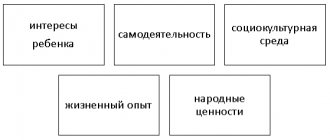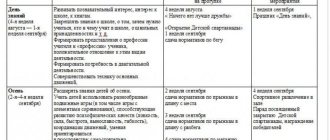The forms and methods of labor education are varied. They depend on the age and other characteristics of the children being raised; are aimed at developing the following qualities: hard work, discipline, conscientiousness, desire for results.
Fostering hard work begins early in life. In the family, then in a preschool institution, basic skills are instilled: ideas about responsibilities, responsibility and discipline. In the future, the forms become more complex and have a specialized character.
The main goal of instilling industriousness is the formation of a little person’s psychological and practical readiness for work . Labor education is very closely connected with civic and moral education; it forms the foundation of creative activity, productivity in studies, sports, amateur performances, and other areas of activity. It is a component of the moral development of the individual.
New trends in labor education methods
Economic, social, environmental conditions determine the constant improvement of labor training and education methods: the emergence of new technologies, the introduction of the latest forms, methods, and techniques. They are based on the principle of variability.
While maintaining the unity of state requirements and their typical nature, labor education programs are drawn up taking into account the composition of those being educated, their age, regional characteristics, and traditions. This opens up opportunities for reducing the use of reproductive methods and increasing the proportion of research and creative forms of work. Inclusion in the labor sphere is carried out taking into account the physiological characteristics , psychological and social readiness of children, taking into account interests and inclinations.
Conditions for successful educational activities
When upbringing, the order of actions, the distribution of responsibilities in the team, the appointment of those responsible, and the availability of forms for summing up are of particular importance. Practical demonstration, training in the main methods, techniques, and compliance with safety are important. It is necessary to use incentives and, if necessary, punishment and censure. Public recognition of work results and approval by adults play an important role.
?
The main condition for success is the inclusion of the child in activities that are feasible for his age and physical capabilities. If it is organized correctly, it will contribute to the formation of the necessary moral qualities: hard work, accuracy, discipline, diligence, perseverance.
Labor becomes educational under several conditions:
- It must be significant and socially useful. This is the only way to realize the significance of the work. Understanding that it brings benefits to people gives additional motivation for work activity;
- The result should be something useful, of value for the team, for oneself and for adults. If the child does not see results, there is not much benefit from the work, the desire to work may disappear;
- Work must be collective. This is the implementation of assigned tasks together, capable of uniting with a common goal. It provides an opportunity to gain experience of interaction, mutual assistance, and solidarity;
- He must be proactive, preferably creative, various forms of self-government and self-organization must be used;
- Labor must be feasible, if possible connected with educational or other educational activities, it cannot be coercion, and punishing a child with it is unacceptable;
- You need to demand not just that the assigned task be completed, but that it be completed carefully and conscientiously.
Labor education in the junior group according to the Federal State Educational Standard
Only if these conditions are met can labor be considered a real means of shaping the personality of a new generation.
We recommend “Problems of labor education of preschool children.”
How to develop hard work in children
For a child to become hardworking, he must be raised. But the most important thing is that he should experience joy from work.
In a playful way, children gain skills and abilities to work
Child labor is unique:
- in terms of content, the work is simple;
- actions are available;
- connection with game processes.
If you watch children, you can see that for 2-3 years the work of an adult is reflected in the game. Children imitate the actions of their elders. Let your child watch adults doing some work. Kids can wash clothes for dolls, wash soft toys, and finally tidy up their room or children's corner. Children aged 5-6 years, as well as seven-year-olds, already play situational games. Such means are excellent in developing labor skills.
Situational games - a fun method of labor education
The content of a child’s work is similar to the content of an adult’s work. It is important that work is meaningful, brings joy and ignites creative impulses.
Types of labor education
The typology of labor education is determined by the type of work performed by the child. It is customary to highlight:
- educational work (physical, mental);
- socially useful;
- production (work to create significant material assets.
Education in educational work is the assimilation, acquisition of the necessary skills, a means of preparation for social labor activity, creativity.
Education through socially useful labor (domestic, social and organizational) includes practical training, work in canteens, on school grounds, collecting scrap metal, planting forests, helping with cleaning, caring for the elderly. This type is intended to show the importance of work activities for society and allows the child to receive moral satisfaction from his activities.
Household work , part of socially useful work, is aimed at satisfying the everyday needs of both the child himself and the team.
Productive work is more suitable for high school age. It is usually paid and is a transition to the real work of an adult.
Early childhood education
Labor education of preschool children includes the following types of activities:
- Self-care – servicing oneself (washing, caring for oneself and others);
- Household - maintaining cleanliness and order at home, in a preschool institution;
- Work in nature: caring for plants, feeding animals;
- Manual, artistic and applied labor contributes to the development of basic skills, abilities, knowledge (work on crafts from different materials, modeling, drawing and other types).
Contents of types of work of preschool children
Self-care: Starting at a young age, preschoolers need to develop self-care skills. But during this period, due to physiological characteristics, children are still unable to perform some actions:
- babies’ fingers are not yet completely obedient;
- the sequence of performing some actions is not always remembered;
- they have not yet developed the ability to control their will.
Work for a child should be feasible and interesting.
These moments are difficult for a child, therefore, the likelihood that they will cause denial is high. What should parents and kindergarten teachers do? Nothing special, just be patient, calm and friendly. Only such means can help a child calmly accept requests to wash his face and brush his teeth in the morning, tidy up his crib, dress and undress independently, and put his toys in order.
Self-service
The means and techniques for mastering self-care activities are quite simple:
- all procedures must be performed regularly;
- monitoring the performance of actions by adults;
- the requirement on the part of adults to do all work carefully, to be tidy and to maintain cleanliness.
Self-service is the first type of work
Advice to parents: older preschoolers should be introduced to school clothes and attributes, the child’s vocabulary should be replenished, and care should be taught in handling these items. For example, prepare clothes with your child in the evening, carefully hanging them on the high chair.
Household labor
Preschoolers must master economic skills and be able to do household work. A child is quite capable of wiping dust on furniture and door handles. The child must represent the content of household work. Methods of labor education allow children in each age category to master new labor actions.
Helping parents is an example of domestic work
The means of developing skills and abilities to perform household work are varied: the child can help set the table, tidy up after himself, sweep the floor. In kindergarten, children are on duty, they also set tables, water flowers, and wipe dust on shelves and cabinets.
Adults need to adjust the content of work depending on their age group.
Advice: do not forget to praise the child, guide him, but in no case scold him, only then the educational goal will be fulfilled.
Work in nature
Labor skills performed in the natural environment are excellent means of experiencing the beauty of one’s native land, developing observation skills and improving movements. The tasks that are presented to this type of work activity are the development of volitional qualities, strength and endurance.
Cleaning the area - outdoor work
What means of labor education are used in this type of work? Children of primary preschool age can feed the fish and birds while walking. Older preschoolers can be assigned to water the flowers in a group. Parents can set similar tasks for their child at home. If the kindergarten has a corner of nature, then children can provide all possible assistance in caring for pets. Also interesting are such means as growing onions or herbs in a jar on the window, as well as observing and caring for plants sprouted from seeds.
Caring for vegetables is a very effective way of labor education
Such means of instilling a love of work in nature are very effective; children become kinder and enjoy the process of work.
Manual labor
Preschoolers should be taught to work with their hands. These are various crafts, working with different types of materials. In classes in kindergarten, children learn the skills of working with natural materials and using various improvised means and paper in creativity.
Children love to make crafts
Manual labor is designed to solve such problems as developing perseverance, developing a sense of aesthetics and patience.
Forms of labor education
Even Makarenko A. was looking for forms of organization that contributed to the formation of a developed and purposeful personality. The main idea of his system was education through labor in the team and through the team. Not everyone knows what form was proposed by Makarenko for the effective education of the younger generation. This form became a combined detachment, which received a modern continuation in the form of squads and volunteer detachments.
All forms aimed at developing hard work are combined into several groups:
- Individual (fulfillment of orders, individual tasks and requirements);
- Collective (socially useful type of work) is aimed at the child’s adaptation in society and the team;
- Group (holidays, matinees, competitions).
There are many forms of education. They are subject to certain conditions. The most popular forms: individual assignments, various types of social work (volunteer teams, shifts, holidays, cleaning, landscaping, landscaping, repairing furniture and textbooks).
Effective forms of developing the right personal attitude towards work are:
- work in units to perform work;
- development of labor traditions;
- shows, exhibitions, competitions;
- detachments and labor landing;
- individual orders.
The labor education system uses the maximum possible number of forms to ensure the education of responsibility, hard work, organization, and collectivism in the younger generation.
Forms of work with preschoolers
The number of forms for preschool children is also quite large. They are distinguished by their simplicity and at the same time invaluable power in educational impact. The most used forms in preschool education:
- Assignments (individual, group and general; short-term, long-term);
- Duty - organization of activities that involve work to serve oneself and the children's team;
- Collective, joint activity is the activity of a group of children united by one goal.
Creativity can also be called one of the forms of developing labor qualities in a preschool educational institution.
Forms of organizing the labor activity of preschool children
Inna Borisova
Forms of organizing the labor activity of preschool children
1 slide.
The choice of one form or another of organizing children’s work depends primarily on:
1) age and psychophysiological capabilities of children;
2) the level of work experience of children;
3) specific educational tasks set by the teacher organizing work activities;
4) content of work.
2 slide.
The content of labor is realized in different forms of organization:
- assignments (for individual children, small groups,
- duty (in the dining room, classes, corner of nature, children taking turns performing duties,
- collective work (organized by the teacher and the children themselves, small groups and the whole group).
Depending on the age of the children, one or another form of organization of children is used. Thus, at a younger age, great preference is given to assignments; at an older age, work increasingly acquires a collective character.
3 slide.
1. Instructions are tasks, requests that the teacher occasionally gives to one or more children, taking into account their age and individual capabilities, experience, as well as educational tasks. This is the first form of organization of labor activity.
Orders can be:
· by form of organization (individual, subgroup, general);
· by duration; (short-term, episodic, long-term);
· according to difficulty (simple, complex).
4. slide.
Taking into account some features of orders, they can be grouped:
Group 1 – instructions related to the implementation of one method of action:
give, bring, carry, help a friend. They are short-term, episodic, caused by temporary necessity.
Group 2 – instructions that contain several methods of action,
several labor operations. This may include the instructions of the following
maintenance: feed animals, water indoor plants, etc.
Group 3 – assignments related to the results that children achieve
not immediately: sow, plant, bring a postcard, comb, etc. from home.
Assignments are widely used in all age groups of kindergarten:
— In the younger group they are the leading form of labor organization. Therefore, work with children on labor education should begin with individual assignments, which the child carries out together with the teacher, and only much later move on to other forms. In younger groups, the instructions are individual, specific and simple, containing one or two actions (lay out the spoons on the table, bring a watering can, remove the doll’s dresses for washing, etc.). Such elementary tasks involve children in activities aimed at benefiting the team, in conditions where they are not yet able to organize work on their own.
— In the middle group, the teacher instructs the children to wash their doll’s clothes, wash their toys, sweep the paths, and rake the sand into a pile. These tasks are more complex, because they contain not only several actions, but also elements of self-organization (prepare a place for work, determine its sequence, etc.).
— In the older group, individual assignments are organized in those types of work in which children’s skills are not sufficiently developed, or when they are taught new skills. Individual instructions are also given to children who need additional training or especially careful control (when the child is inattentive and often distracted), i.e., if necessary, individualize the methods of influence.
— In a preparatory group for school, when carrying out general assignments, children must demonstrate the necessary self-organization skills, and therefore the teacher is more demanding of them, moving from explanation to control and reminder.
5. Slide.
2. Duty is a form of organizing children’s work, which involves the work of one or more children in the interests of the entire group.
On duty, to a greater extent than on assignment, the social orientation of work, the real, practical care of several (one) children for others are highlighted, therefore this form contributes to the development of responsibility, a humane, caring attitude towards people and nature.
In the younger group, in the process of running errands, children acquired the skills necessary to set the table and became more independent when doing work. This allows the middle group to introduce canteen duty at the beginning of the year. There is one person on duty at each table every day. In the second half of the year, duties are introduced to prepare for classes. In older groups, duty in a corner of nature is introduced. The duty officers change daily, each of the children systematically participates in all types of duty.
Having learned all this, children master the ability to coordinate their actions, negotiate, and distribute responsibilities independently. It is important to maintain consistency and promptly transfer children from one level of difficulty to another. The teacher pays attention to the pace and quality of work. Duty duty contributes to the systematic inclusion of children in work activities. The tasks, duration and content of duty depend on the age of the children and the educational purpose. The main meaning of duty is caring for others.
6 slide.
3. General, joint, collective work primarily contributes to solving the problems of moral education. General, joint and especially collective work creates favorable conditions for the development in children of the ability to coordinate their actions, help each other, establish a uniform pace of work, and complete a task within a certain time frame.
Common work presupposes an organization of children’s work in which, with a common goal, each child performs some part of the work independently and at the end of the work the overall result is summed up.
Example: The teacher invites the children to restore order in the group and distributes responsibilities. After finishing work, the teacher draws attention to the fact that everyone is working well. And here is the result - the group is clean and beautiful
Joint work involves the interaction of children. In the process of work, children become dependent on each other: on the pace and quality of the work of others. Joint work gives the teacher the opportunity to cultivate positive forms of communication between children: the ability to politely address each other with requests, agree on joint actions, and help each other.
Example: who to assign Nastya to work with - she gets distracted, what task is best to give to Yura - he doesn’t know how to work quickly, etc.
Collective can be called a form of labor organization in which children, along with labor ones, solve more complex - moral - problems: they agree on the division of labor, help each other if necessary, turn to peers for help, rejoice at their successes, the general results of work, They are worried about the quality of common, joint work. The collective form contributes to the targeted development of collective relationships and creates a positive emotional mood.
So, not every common and not even every joint work is collective. But every collective work is common and joint. It is important that the teacher knows how to organize truly collective work of children.
Methods of labor education
There are several groups of methods:
- Methods of forming consciousness, used to form views, ideals, beliefs, attitudes. They contribute to the formation of feelings and moral experiences. Methods of personality formation are methods of persuasion: they convince the child of the correctness of actions, allow him to understand the need for work as an obligatory part of society . Persuasion can be achieved using methods: stories, explanations, suggestion, instruction, example, conversations;
- Methods of organizing socially significant activities allow the child to understand the role of his work and the benefits it brings;
- Stimulation methods: proper encouragement or punishment, competition. Approval from adults is always important; as a result, the child can experience inner satisfaction, the realization that he has achieved success in completing the task. Blame is also important.
Labor education at school
The choice of methods depends on the goals and objectives, the individual characteristics of the individual child, and the level of work readiness.
Forms and methods of organizing the educational process
In a kindergarten group, children can do the following work, the purpose of which is labor education:
- Orders are the simplest methods. The baby is given a specific task that he completes. The system of individual orders has proven itself well.
- Duty - kids learn to be responsible for the assigned task, to be careful and efficient.
- Common work solves the problems of moral education. It is introduced in senior and preparatory groups.
- Business relationships are built between preschoolers in the process of common work.
What are the main means for instilling a love of work in preschoolers?
The example of adults is the best means of labor education
. Basic means:
- own labor process, which is carried out by preschoolers;
- familiarization with the process of work performed by adults;
- knowledge of the labor process through creativity and artistic development.
So, in the process of labor education, preschoolers should develop the concept of the labor process. Attitude to work and work activity, skills to perform certain types of work appropriate to age.
Preschool teachers and parents must act in cooperation and close cooperation.






